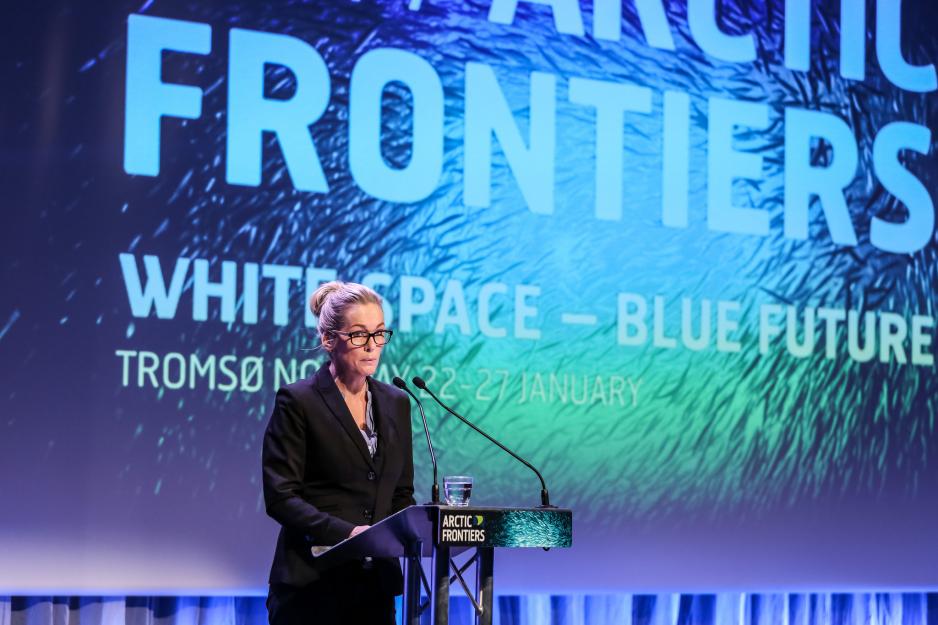Speech: Capturing on competitive advantages in the Arctic

I planned to start like this: The Arctic Circle is a magical circle. We perceive everything beyond 66o N as wild, exotic, pure and...
Then a colleague from Finnmark stopped me; - Anita, how is it that everyone who come to the arctic always point out how special we are? We need exactly the same as any other region: to fix the basics, an infrastructure of competent capital, companies and network.
He’s right. If we all continue to talk high-level about the Arctic, about sustainability and geopolitics – (if there’s one place in the world where the sustainability message is clearly understood and must be basis for everything we do, it’s here) – we might be missing out on fixing the basics - the real bottlenecks that stand in the way of creating new businesses and jobs with growth potential in the High North.
I believe we need to listen more to the people who actually live in the Arctic, and after doing so we can reassess our perception.
There are many Arctics. The Russian Arctic, The Canadian Arctic and where we are now in Tromsø, the Scandinavian Arctic.
The Scandinavian Arctic, at the apex of Europe, heated by the Gulf Stream, is the most densely populated area in the Arctic, while simultaneously the most sparsely populated region in Europe.
This region is located close to oil and gas deposits, abundant in fish with a promising environment for fish farms, rich in ores and minerals, in addition to its favorable position at the gate of the Northern Sea Route and a magnet for tourism and creative industries. All these attributes put the Scandinavian Arctic in pole position for future development.
But how do we capture on this pole position?
We typically generate growth by our ability to create more jobs, build new companies, expand and transform existing companies, increase investments, improve our education, and attract and maintain talents.
This is also key for the Arctic moving forward.
Research and politics are already mobilized - now we need to increase our focus on building and attracting new businesses, creating new jobs and making the Arctic a hub for large, innovative projects. And that is what Innovation Norway Arctic is here to do.
Based on the knowledge and input from our existing Arctic customers and my colleagues, these are our three recommendations:
Firstly: Increase the transfer of research-based knowledge into building new businesses and technologies
Over the years, Norway’s Arctic policy has focused on fostering knowledge about the Arctic and for the Arctic.
But if we are to capture value from this special Arctic knowledge and investments, we need to 1) commercialize ideas based on the research activities and new technologies and 2) ensure more research based on the needs of the companies.
We need to work harder to use the insight and knowledge obtained to generate ideas.
Those ideas can be new products, new processes or new services. It may also be a new application of a technology currently in use today. And then the ideas will need to be turned into viable business cases.
The researcher is often not the right person to understand, nor drive, the process of turning research into new business ideas. Therefore we need different people involved, we need more technology transfer competence, which was expressed yesterday at Abelia’s side event about new technologies for the Arctic.
Secondly: Competent capital - Access to capital is by no means a new problem, nor is it specific to the Arctic.
Private investors tend to use their financial resources within a relatively modest geographical area or within the specific industry they are familiar with. The Arctic is not a "low-maintenance grab" for the average investor. Climate, distance, population, political and cultural processes - to name a few.
There is also an expectation (or maybe a myth?) in the Arctic that capital investments should come from the government.
We believe that there is a need to build a larger share of private investors and venture ecosystems cooperating with the public sector in the Arctic. One or two is not enough, we need a critical, long term, focused mass to deliver on the huge investment potential that the Arctic represents.
We need people to identify and build visions of large projects that attract capital and competence. Ambitious projects challenging our traditional mindset; they need to be scalable; they need to be job intensive. They need to be formed now, and invested in, as it will take time, maybe a generation, to build to reach its potential.
This is a task for the younger generation. Give them responsibility and trust, don’t forget - they are born global natives and can deliver and mobilize young talents from all over the world.
Lastly: Cooperation
This region will always be remote in the national, south-north perspective. The consequence is that businesses in this region need to constantly look towards more central areas to find both partners and a market for their goods or services. They cannot operate alone to create massive and scalable projects. They need to build strong, long-distance networks, as well as to create the Arctic as a base, a working hub.
So far, this has not been the strongest competitive advantage for the Arctic. But by shifting the focus from traditional national north-south perspective to an east-west global perspective, one can turn the geographical disadvantage into a competitive advantage by employing the opportunities and advantages that lie across the borders.
In addition to creating competitive advantages for individual entrepreneurs, this also contributes to stability within the border area in a political, economic, cultural, and social sense.
We need to strengthen the cooperation both within national clusters and across borders.
2017 started well with normalizing our relationship with China after six challenging years - let’s not stop there, let’s continue our dialogue and relationship with our close neighbor Russia. It’s important for the future of the Arctic.
Finally: a last message from my good colleague in Finnmark:
- Anita: We’re world leading in the ocean space industries. And in order to be able to continue to belong in the world class league, we cannot afford not to fix the basics of creating an innovative infrastructure in the Arctic. We need to create an ecosystem of private and public competent capital. We need to learn how to build commerce based on all the research we have put into this area and we need to build on our strong relationships with our eastern neighbors.
I believe he’s right.
This speech was held during the Arctic Frontiers business conference in Tromsø 25 January 2017.

